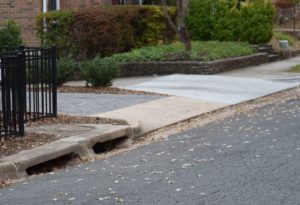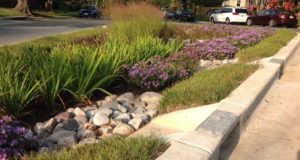Wet Weather Turns into Water Runoff
Stormwater runoff is the single largest cause of water pollution, flooding and property damage. According to FEMA, just one inch of rain can cause $25,000 of damage to your home. More than 22.4 million US properties are at risk of flooding this year, and annual damages from flooding in the US are expected to increase by 30% by the end of the century.
Stormwater also poses a massive threat to our water pollution: 70% of all water pollution comes from pollutants carried in stormwater runoff. An estimated 10 trillion gallons of untreated stormwater runoff, containing everything from raw sewage to trash to toxins, enters US waterways from city sewer systems every year, polluting the environment and our drinking water supplies.
So what can green infrastructure like green roofs, permeable pavers, and rain gardens do about flooding and polluted water runoff?
Modern Methods for Sustainable Water Management
When focusing on ways to navigate stream pollution and polluted runoff, engineers have developed ways to offset water runoff from rapidly entering into our waterways. Here are projects most common for preventing water pollution.
Green Roofs
Green roofs are covered with growing media and vegetation that soak up rain and enable infiltration and evapotranspiration. Installing a green roof on your property can significantly reduce your stormwater runoff and by doing so reduce flood risk and water pollution. A study done by a University of Toronto civil engineer and co-researchers at the school’s Green Roof Innovation Testing Lab showed that green roofs have the capacity to capture an average of 70% of rainfall over a given time.
Permeable Pavers
When rainfall flows over standard concrete driveways and sideways (impermeable surfaces) it contributes to our stormwater problems by picking up pollution, overwhelming our local water systems and posing a flood risk. The switch to permeable pavers helps prevent flooding and reduces pollution by allowing water to seep back into the ground and be filtered at the same time. For example, if you have a 1,000 square foot driveway, permeable pavers enable you to store close to 3,000 gallons of water under your driveway. Additionally, pavers are up to four times stronger than concrete and last two times longer. Permeable pavers have joints which make it flexible and durable as the ground changes. Unlike concrete paveways, it won’t crack when there is an earthquake or when the ground beneath contracts and expands. They also have a higher resale value than concrete because of their longer lifespan and visual appearance.
Rain Gardens
Rain gardens also known as Bioretention, are shallow vegetated basins that collect and absorb stormwater runoff from rooftops, sidewalks, and streets.
According to the Groundwater Foundation, compared to a conventional lawn, rain gardens allow for 30% more water to soak into the ground. Rain gardens are also effective in removing up to 90% of nutrients and chemicals and up to 80% of sediments from the rainwater runoff. A rain garden neutralizes pollutants and allows water to soak into the ground rather than overwhelming our water systems or contribute to flooding.
In an analysis of Seattle area rain gardens, researchers estimated that each one can filter as many as 30,000 gallons of stormwater a year, enough to fill a bathtub 600 times. Another study in Burnsville, MN showed a 93% reduction in stormwater runoff volume after the installation of 17 rain gardens in a 5.3 acre neighborhood.
Green Infrastructure is Good for Your Wallet, Too.
It’s easy to see that integrating green infrastructure in urban areas and using the power of nature can have significant positive results for our cities and the environment. You too can introduce green infrastructure to your property while enjoying all the benefits—and it can be more accessible than you may think. It has been estimated that green infrastructure is 5%-30% less costly to construct and about 25% less costly over its life cycle than traditional infrastructure. On top of that, green infrastructure increases property value too.
Using green infrastructure in construction and increasing vegetation and tree cover can increase your property value, whether you’re a homeowner or developer. For an office building, adding landscape adds approximately 7% to the average rental rate. There’s benefit for retail too: consumers are willing to spend more on products, visit more frequently, or travel farther to shop in areas with attractive landscaping, good tree cover or green streets. For homeowners, green infrastructure can add great curb appeal and value to your home. Landscaping that is properly done can add 10%-15% to the value of a home.
There’s even more financial benefit with the lower energy bills that come with green infrastructure. Green roofs provide insulation and help keep buildings cold in the summer and warm in the winter. Research published by the National Research Council of Canada found that an extensive green roof reduced the daily energy demand for air conditioning in the summer by over 75%. Even just adding trees to your property can make a difference: trees can reduce the heat load on your home by 10% to 30% cutting air-conditioning costs in the summer and reducing heating requirements by a similar percentage in the winter.
Create a Rainplan to Find Green Infrastructure Opportunities on Your Property
Installing green infrastructure becomes even more appealing with government stormwater incentives and rebates which can significantly reduce installation costs. But the process to apply for these incentives can be burdensome, confusing and lengthy.
Rainplan can take care of all the hard work from start to finish. Discover which incentives are available to you with Rainplan’s online platform. After reviewing your Rainplan, if you are ready to move forward, Rainplan will then handle all of the paperwork, match you with reputable installers and green infrastructure experts and secure your funding upfront. With the help of Rainplan, you can install green infrastructure seamlessly and take pride in the financial, structural and environmental benefits that come with it.




